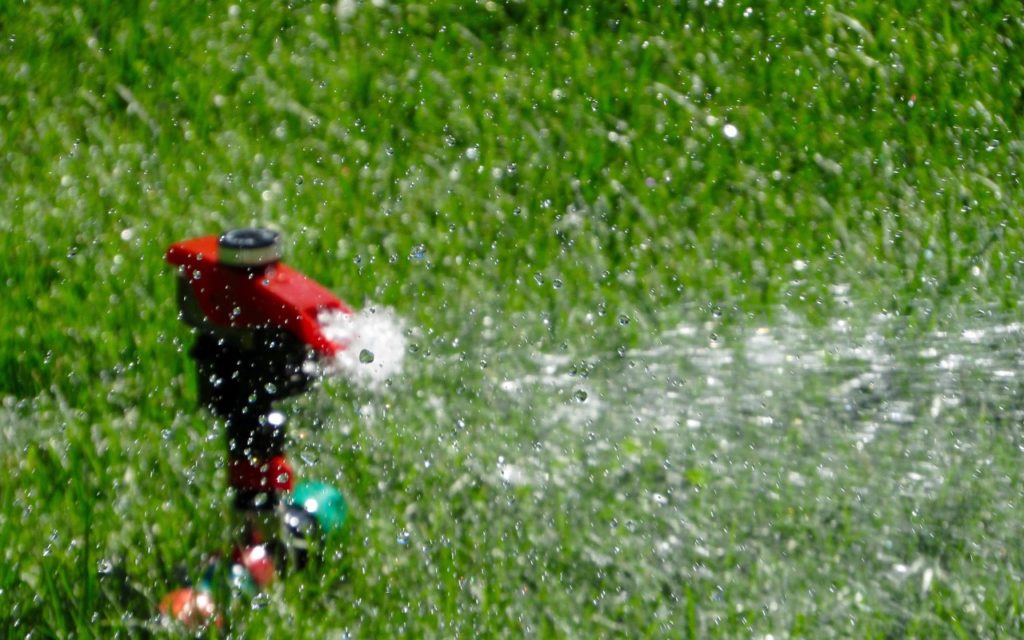For most of the year in the Pacific Northwest, we live with the luxury of not having to worry about watering our lawns. But when the rain finally stops, and the days get warmer, here in Vancouver, Camas, and Washougal, Washington, it’s high time to bust out your go-to watering system. Be it a hose end sprinkler or an in-ground system, it’s always worth brushing up on lawn watering techniques as the rainy season fades away.
Having a healthy lawn is usually the result of trial and error. Dethatching, aerating, over-seeding and fertilizing all make a dramatic difference, but even the effects of these beneficial services can be hindered by improper watering. Our hope by the end of this post is to educate you on effective watering habits that will, hopefully, equip you with the information needed to enjoy a happy, healthy lawn.
How Often Should I Water My Lawn?
The average lawn requires about 1 to 1 1/2 inches of water every week to stay green and lush. That said, there are several factors that can make that number higher or lower. Sunlight, soil type, grass type, and the region’s climate all play a role in your lawn’s health. For example, if you find lots of different puddles every time you water, odds are that your soil has high clay content. Soil with a substantial amount of clay doesn’t absorb water very quickly but retains more water than its sandy counterpart. Although this may be disheartening to see, all it requires is shorter, more frequent watering.
This is also a technique to use for a lawn that has a slope or that is located on a hill. Many people who have these types of lawns run across the issue of water draining right down the incline and often onto the street below. Watering for half the time you normally would, twice a week, is an easy fix. A clever way to determine watering time is to set a few tuna cans (or something similar in size) at different spots on the lawn, all marked at the one-inch line. Set a timer and see how long it takes for the water to reach the marked line and, viola, you have your ideal watering time.
That said, watering less frequently for longer durations is the ideal way to go about it. This practice encourages deep grass root growth, which is essential in having a low maintenance yard. Of all the available systems, hose end sprinklers provide the most bang for your buck (provided you have a small to mid-size yard). These sprinklers seem to be the most common and for good reason. When looking for a hose end sprinkler, try to find one that waters in a shape similar to your yard. Simply take it home, screw it on your hose, and set a timer!
In-Ground Sprinkler
Another popular option is the in-ground sprinkler system. Although they can be costly, in-ground systems are, undeniably, the most effective for larger lawns. The tips and tricks for designing and installing your own system are endless, but here’s a good article to get you started.
After your in-ground system has been installed, it’s important to make sure that every section of the yard is being watered. Turn the system on and take a walk around the lawn. If any of the heads aren’t reaching a section in need of watering, make the necessary changes to the heads or the water pressure. One good habit to pick up when using in-ground watering systems is implementing low-volume, low-angle heads. High volumes and high angles cover a lot of ground but result in a wasteful amount of water evaporation. If the water pressure and angles are low, evaporation is minimized. When considering unnecessary water waste, it’s important to avoid a couple of other malpractices as well.
Avoiding Common Mistakes
A common mistake people make is inadvertently watering their sidewalk. How often have you walked by a freshly watered lawn and seen a soaking wet sidewalk? Adjusting sprinkler heads away from the sidewalk not only maximizes their ability to cover the lawn but keeps water waste down to a minimum. This aside, the biggest offender on the road to eliminating water waste is the broken sprinkler. One single broken sprinkler head can result in 750 gallons of water waste per hour of operation if left unrepaired. That’s thousands of gallons per month. Be sure to routinely check your sprinkler heads and swap out any that seem damaged.
Determining your lawn’s water needs is a delicate process. 1 to 1 1/2 inches of water, every week, is the ideal jumping off point. Watering the lawn for longer durations less frequently promotes deep and healthy grass roots. Whatever method you end up using, be sure every inch of the lawn is being covered, and nothing is going to waste. With any luck, your lawn will be lush and green in no time! If you have any questions regarding your lawn’s health or watering techniques you can reach Urban Eden Landscaping at 360-567-6399, contact us here, or fill out a free estimate request online.

